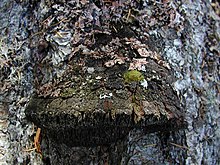| Echinodontium | |
|---|---|
 | |
| Echinodontium tinctorium | |
| Scientific classification | |
| Domain: | Eukaryota |
| Kingdom: | Fungi |
| Division: | Basidiomycota |
| Class: | Agaricomycetes |
| Order: | Russulales |
| Family: | Echinodontiaceae |
| Genus: | Echinodontium Ellis & Everh. (1900) |
| Type species | |
| Echinodontium tinctorium (Ellis & Everh.) Ellis & Everh. (1900) | |
| Synonyms [1] | |
Echinodontium is a genus of fungi in the family Echinodontiaceae. The genus was published by American mycologist Job Bicknell Ellis in 1900, who described it thus: "Differs from Hydnum in the thick, woody pileus of Fomes and the teeth beset with spines, as in Mucronophorus and Hymenochaete ". [4] The type species, Echinodontium tinctorium , is commonly known as the "indian paint fungus" owing to its traditional use for bodypainting. [5]